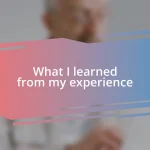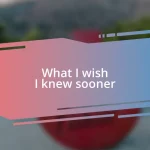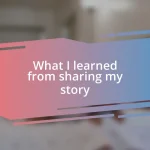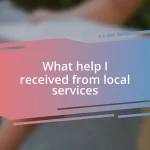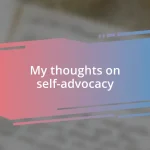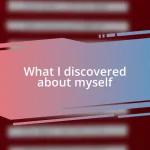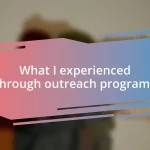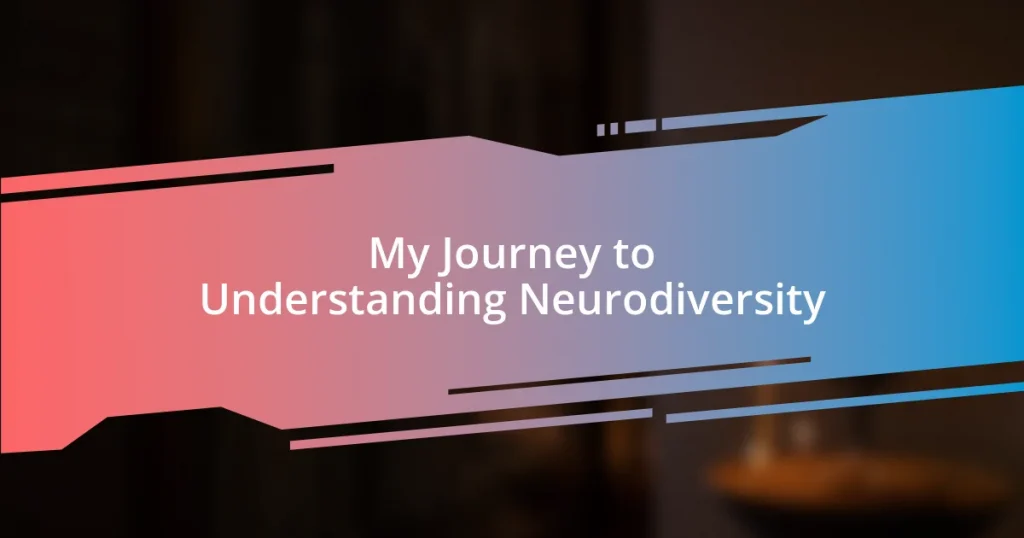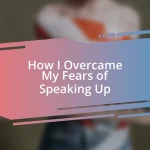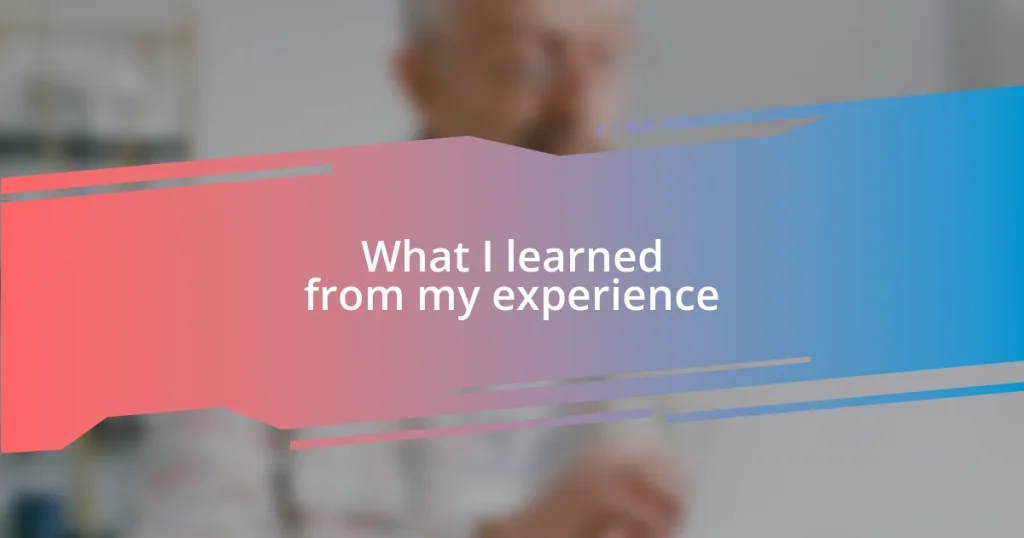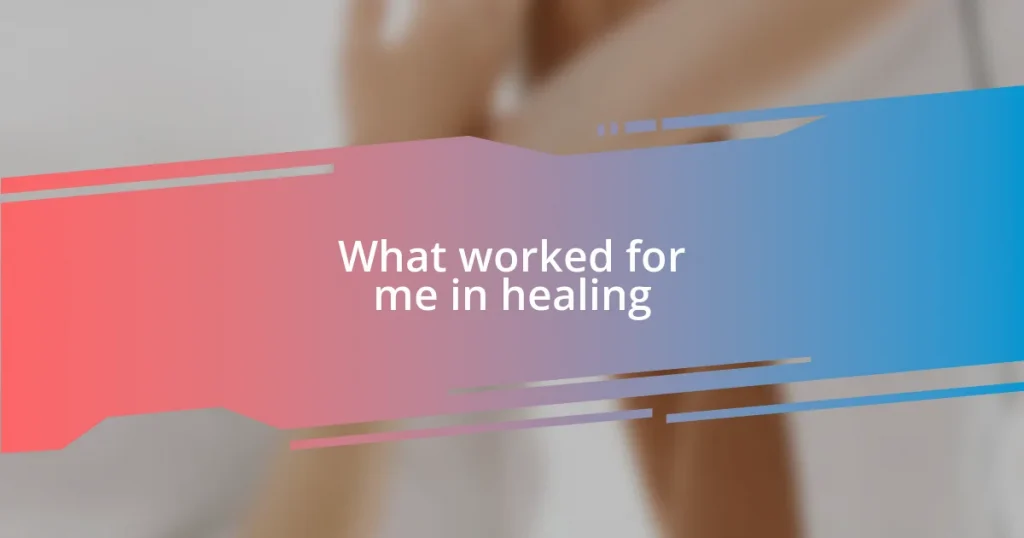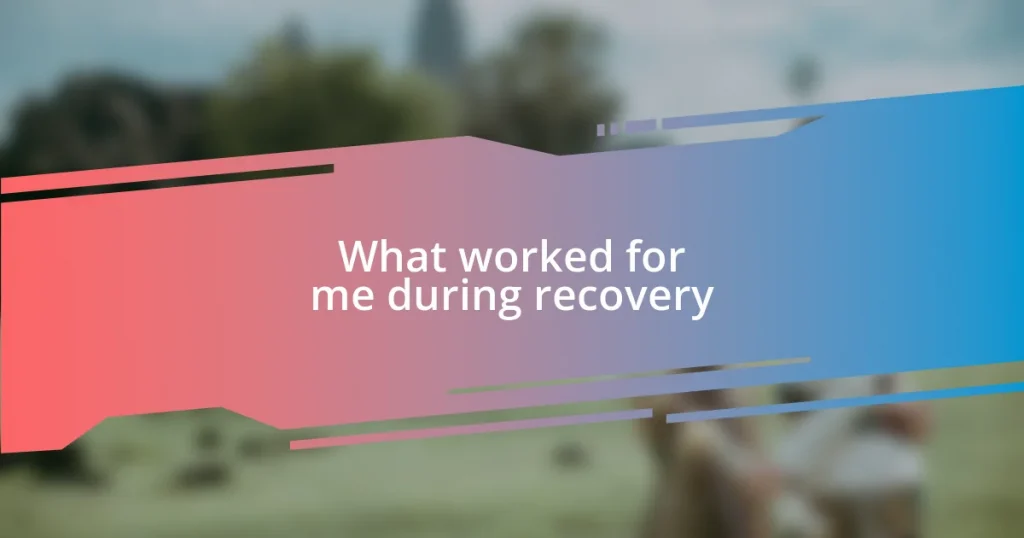Key takeaways:
- Realizing the value of neurodiverse perspectives through personal experiences, such as friendships with individuals on the autism spectrum and ADHD, highlighted the strengths and creativity within diverse thinking.
- Engagement with neurodiversity advocates emphasized the importance of amplifying their voices, fostering supportive environments, and addressing biases to create more inclusive communities.
- Implementing practical strategies for inclusion, like initiating open conversations and creating sensory-friendly spaces, proved essential in validating experiences and accommodating diverse needs in various settings.
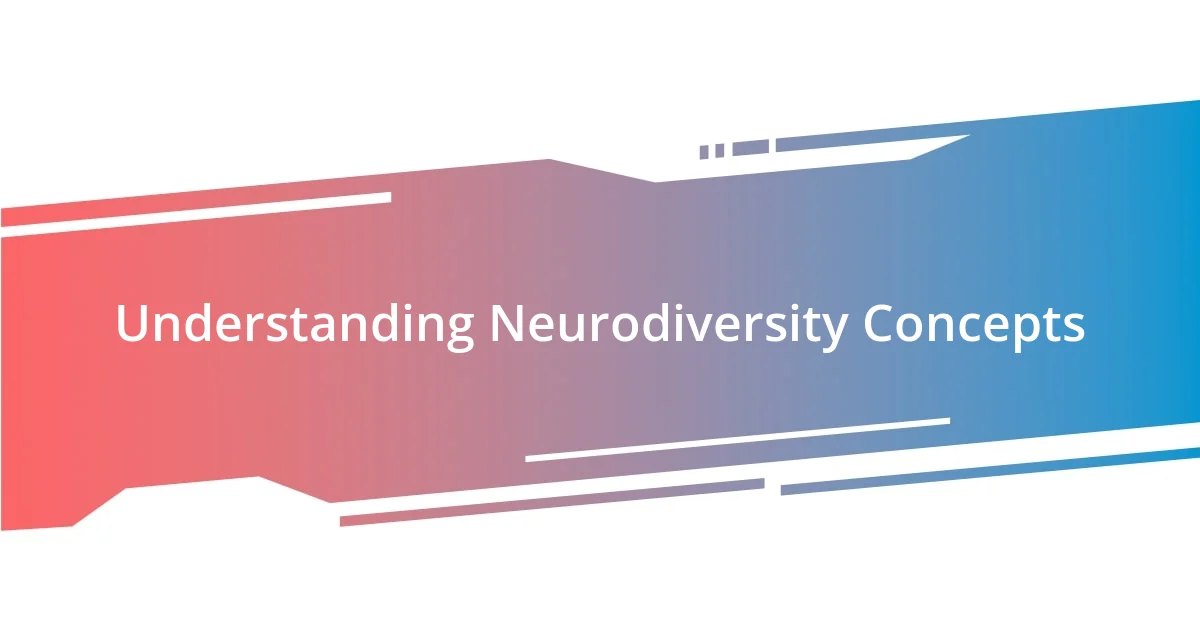
Understanding Neurodiversity Concepts
At its core, understanding neurodiversity means recognizing and embracing the variety of ways people think and process information. I’ll never forget the moment I realized that my sister, who has ADHD, experiences the world through a different lens. It hit me – are we not all a bit neurodiverse in our unique ways?
Neurodiversity isn’t just about diagnosis; it’s about cultivating a mindset that values differences rather than stigmatizing them. For instance, when I joined a support group for families of neurodiverse individuals, I was struck by the powerful stories shared by parents. They highlighted strengths in their kids that often go unnoticed, such as heightened creativity or unique problem-solving abilities, making me wonder: what strengths do you see in your own neurodiverse friends or family?
When discussing neurodiversity, terminology is key. Words like “autism,” “ADHD,” or “dyslexia” are often only seen as labels, but I urge you to see beyond that. Each term represents a rich tapestry of experiences and talents. I recall a friend who struggled with dyslexia; while reading was a challenge, her artistic abilities shined bright. This makes me think: how often do we overlook the brilliance hidden behind differences?
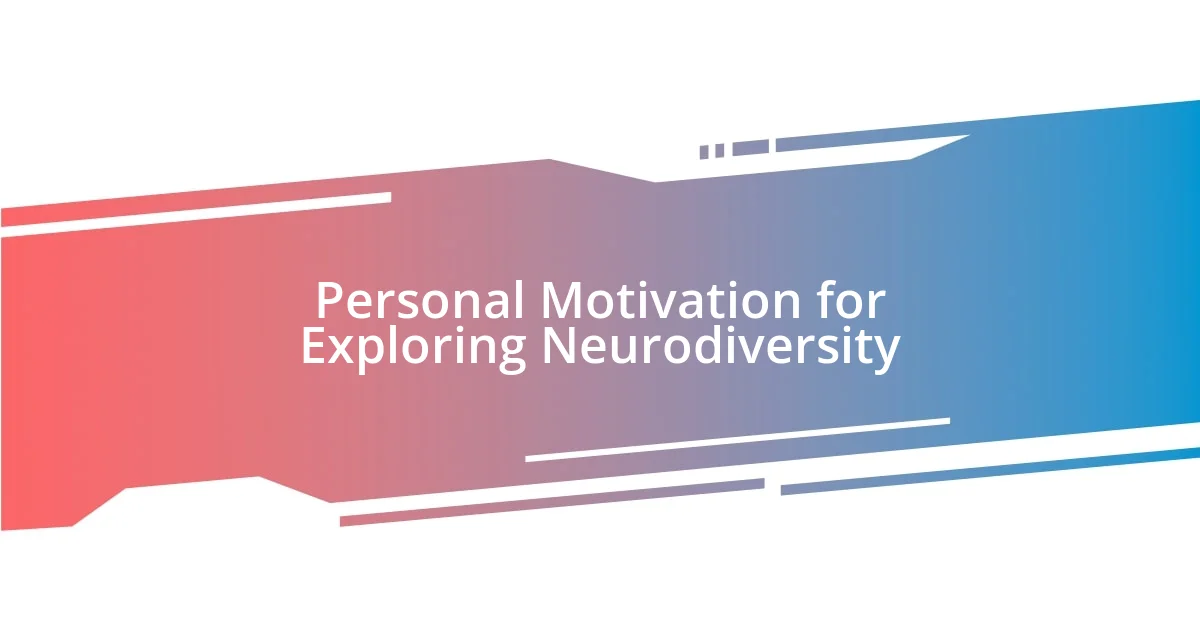
Personal Motivation for Exploring Neurodiversity
My personal motivation for diving into the world of neurodiversity emerged from my own experiences. I’ve always had a fascination with the quirks of human behavior, but when a close friend was diagnosed with autism, it felt like a call to action. As I learned more, I became increasingly aware of my own biases and lack of understanding about the spectrum of neurodiversity. This journey wasn’t just about knowledge; it became a quest to unravel the complexities of how diverse brains can enhance our communities.
I remember attending a workshop where the speaker, a neurodiverse individual, shared their struggles and triumphs. Their raw honesty about feeling out of place in conventional settings resonated deeply with me. It made me reflect—how often do I dismiss or minimize differences that challenge the status quo? This realization ignited a passion within me to advocate for inclusive spaces that celebrate variations in thinking and processing.
Exploring neurodiversity has also opened my eyes to the intersection of creativity and thought diversity. One of my favorite moments was collaborating on a group project with individuals who thought differently. A colleague with ADHD proposed a unique approach that initially seemed impractical. However, this radical idea ended up being the cornerstone of our success! That experience taught me that embracing neurodiversity not only enriches problem-solving but can also lead to innovative breakthroughs.
| Personal Motivation Insights | Key Experiences |
|---|---|
| Awareness Journey | Close friend’s autism diagnosis |
| Emotional Resonance | Workshop speaker’s honesty |
| Creative Collaboration | Successful group project with diverse thinkers |
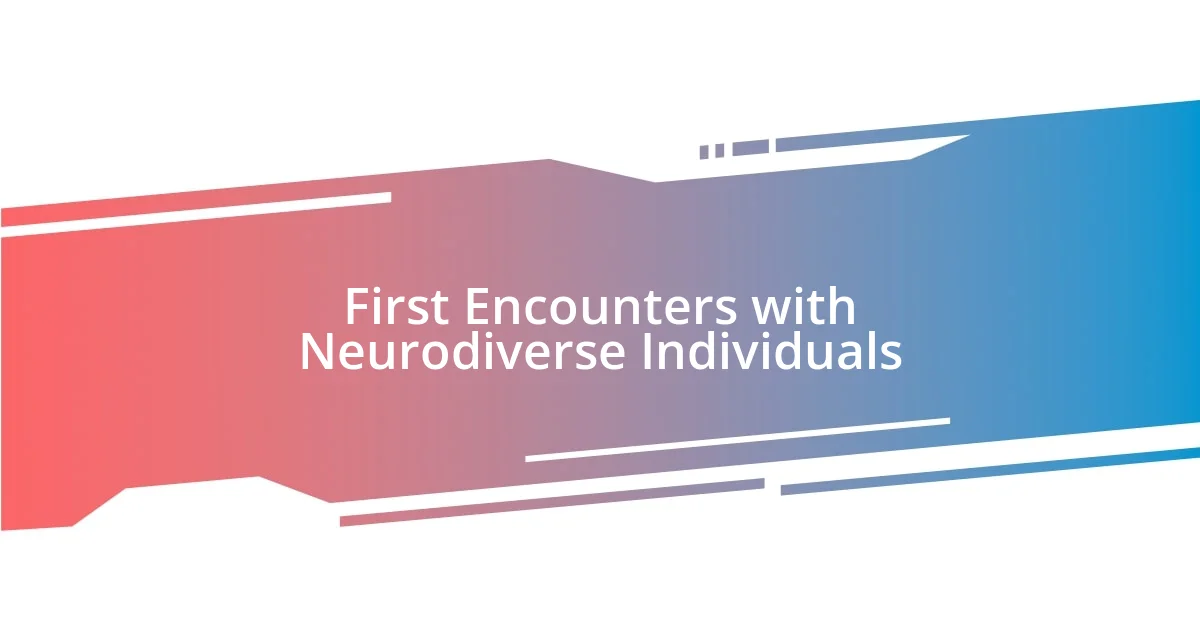
First Encounters with Neurodiverse Individuals
I still remember the first time I met someone on the autism spectrum. I was volunteering at a local community center and was paired with a teenager named Jason. Initially, I misread his quiet demeanor as shyness, but soon I realized it was his way of processing the environment around him. I felt an overwhelming sense of connection when he shared his passion for coding, revealing a brilliance I hadn’t anticipated.
- It struck me how unique each individual’s experience is.
- I noticed that my assumptions about communication styles were challenged.
- I learned the importance of patience and open-mindedness in those interactions.
Another impactful experience was during a college group project where I collaborated with Mia, who has ADHD. At first, I struggled to keep up with her rapid-fire ideas, feeling slightly overwhelmed. However, I quickly adapted and started appreciating her creative thinking. Our brainstorming sessions became a whirlwind of inspiration, with her imaginative leaps pushing the boundaries of our project. It taught me that embracing neurodiverse perspectives can lead to unexpected and beautiful ideas.
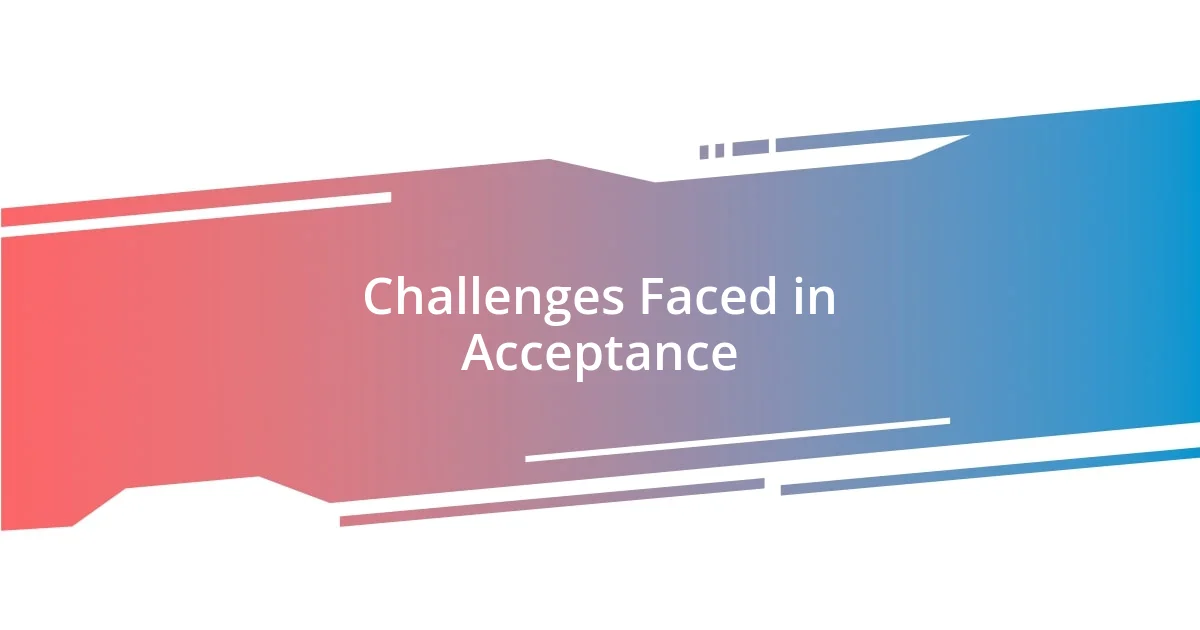
Challenges Faced in Acceptance
Navigating the journey of acceptance within the realm of neurodiversity feels like walking through a maze at times. I remember grappling with my own preconceived notions, wondering why I found it so hard to shift my mindset. It was a complex realization—I had to confront layers of societal conditioning that labeled differences as deficits rather than gifts. How could I challenge these ingrained beliefs while fostering a more inclusive perspective?
In my experience, one of the biggest hurdles in accepting neurodiversity lies in the fear of the unknown. There were moments when I hesitated to engage with neurodiverse individuals, worried about saying the wrong thing or not knowing how to communicate effectively. This fear can be paralyzing. Yet, I found that each encounter was an opportunity for growth. I began asking questions, allowing myself to be vulnerable, and discovering that most people appreciate genuine curiosity far more than perfection in social interactions.
The emotional impact of truly accepting neurodiversity can also feel overwhelming. I vividly recall a moment when a friend unexpectedly opened up about their struggles with sensory overload in public spaces. Their honesty pierced my heart, evoking compassion but also sparking an urgency in me. I wondered—what could I do differently to create a safer environment for my friends? This drove home the point that acceptance is not a destination but an ongoing process. Every step, every conversation gradually dismantles stigma and fosters understanding.
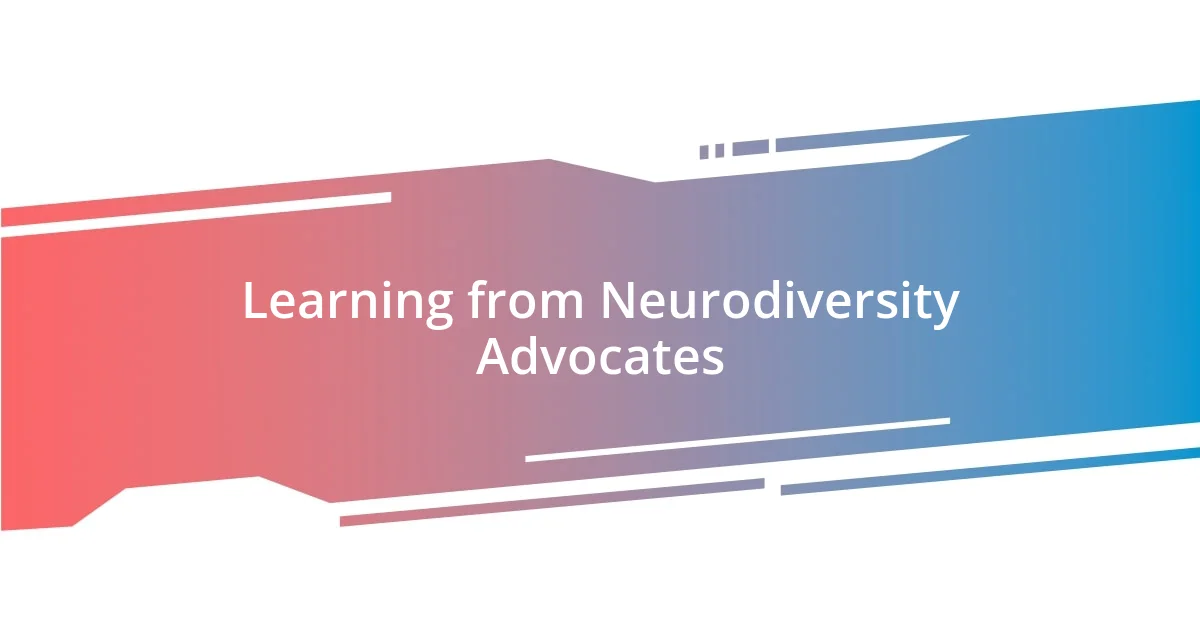
Learning from Neurodiversity Advocates
Learning from neurodiversity advocates has profoundly reshaped my understanding of the diverse neurological experiences around us. One transformative moment occurred during a workshop led by an advocate with dyslexia. As she shared her journey of navigating a world that often felt unwelcoming, I was struck by her resilience. It made me question, how often do I take the time to appreciate the different strengths each of us brings to the table? Her story reminded me that neurodiversity is not just about the challenges; it’s also about the gifts and perspectives that can enrich our communities.
I recall attending a panel discussion where a group of neurodiverse individuals shared their insights on advocacy and inclusion. Their candid reflections on experiences—ranging from workplace challenges to social misunderstandings—deeply resonated with me. Listening to their stories, I felt a sense of urgency to address my own biases. It dawned on me that amplifying neurodiverse voices is vital, not only for personal growth but also for fostering a more inclusive society. How can I influence my own circles to ensure that everyone feels valued for who they are?
Engaging with advocates has not only broadened my perspective but has also illuminated the importance of building supportive environments. I recall one individual emphasizing how crucial it is for workplaces to adopt flexible policies that recognize different working styles. This provoked me to think—am I contributing to an atmosphere that celebrates neurodiversity? The conversations I’ve had with these advocates continue to inspire me to implement small changes in my daily interactions, creating spaces that embrace differences rather than shy away from them.
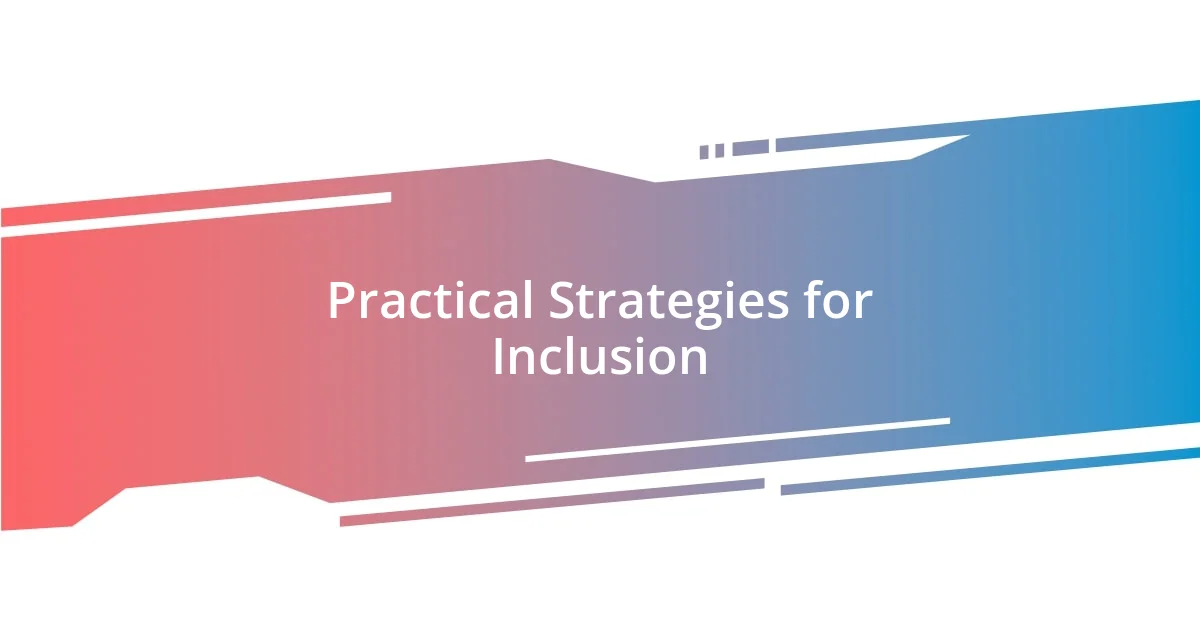
Practical Strategies for Inclusion
Creating practical strategies for inclusion starts with fostering open communication. I remember a time when I initiated a casual meeting in my workplace to discuss neurodiversity openly. This simple step encouraged my colleagues to share their thoughts and concerns, sparking enlightening conversations. I realized then that providing a space for dialogue not only validates experiences but also dismantles misconceptions. How often do we overlook the power of a simple conversation?
Another effective strategy is to implement sensory-friendly spaces. I once tailored a small corner in my office with softer lighting and noise-canceling headphones, inspired by a friend who struggled with overstimulation. This area became a retreat for anyone needing a moment to recharge, reinforcing the idea that accommodating different needs can enhance everyone’s productivity. I found myself asking: What small changes can we make in our environments to ensure all voices are heard?
Lastly, I found that advocating for diverse representation in decision-making processes is crucial. During a community project I participated in, we actively sought input from neurodiverse individuals at every step. Their insights led us to rethink our approach and ultimately improve our outcomes. This experience highlighted that inclusion isn’t just a checkbox—it’s about weaving diverse perspectives into the fabric of our planning. How can we better invite underrepresented voices into our discussions?
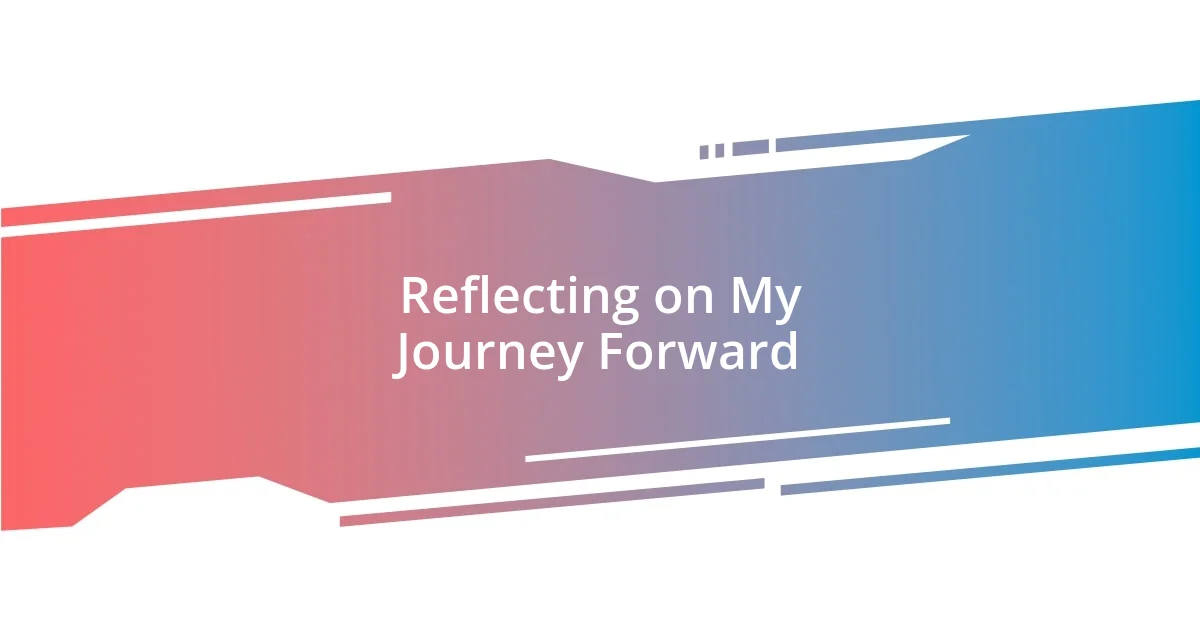
Reflecting on My Journey Forward
Reflecting on my journey forward, I recognize that my understanding of neurodiversity is still evolving. I recall a recent moment when I chatted with a colleague who identifies as ADHD. As we discussed our differing approaches to tasks, I was struck by how her unique perspective inspired innovative solutions, pushing me to reconsider the way I view challenges. Isn’t it fascinating how our differences can lead to creative breakthroughs?
I also find myself contemplating how I can actively contribute to a more inclusive environment. One day, while participating in a virtual meeting, I noticed a quieter team member struggling to share their ideas. I felt a strong urge to advocate for them, reminding myself of the importance of giving everyone an opportunity to be heard. How often do we let valuable voices go unheard simply because of the dynamics in our discussions?
As I move forward, I’m motivated to continue my self-education about neurodiversity. Recently, I enrolled in an online course that focuses on empathy and understanding diverse neurological experiences. It’s a small step, but I believe that each ounce of knowledge gained can ripple outwards. How can my journey inspire others to take action too? I’m learning that every step counts, no matter the size.
